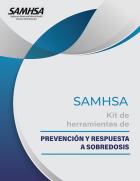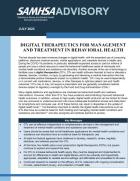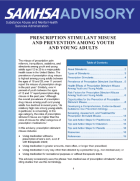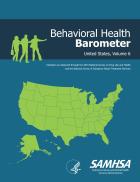Dashboard: Filter Bricks
Main page content


This Advisory outlines how healthcare providers (i.e., obstetrician-gynecologists [OB-GYNs], primary care physicians, and other professionals who treat pregnant people) can take an active role in supporting the health of pregnant individuals who have OUD and their babies.


This advisory introduces readers to digital therapeutics (DTx) and the benefits of their use in behavioral health. It describes the research, regulatory, and reimbursement implications for DTx as well as selection and implementation considerations.

This Advisory reviews the evidence on prescription stimulant misuse among youth and young adults. It establishes prescription stimulant misuse as a public health problem, identifies associated risk and protective factors, and provides programs and action steps for stakeholders to prevent misuse.

The Executive Summary of this Treatment Improvement Protocol provides an overview on the use of the three Food and Drug Administration-approved medications used to treat opioid use disorder—methadone, naltrexone, and buprenorphine—and the other strategies and services needed to support recovery.

This Treatment Improvement Protocol (TIP) reviews the use of the three Food and Drug Administration (FDA)-approved medications used to treat OUD—methadone, naltrexone, and buprenorphine—and the other strategies and services needed to support recovery for people with OUD. This is a revision.

A brochure for parents and caregivers about the risks associated with misusing prescription pain medications for teens and the importance of having conversations with their children to help them avoid taking medication that is not theirs.

The EAP Prescription Drug Toolkit and Fact Sheets provide guidance related to counseling, referrals, and follow-up services (e.g., alternatives to prescription drugs, workplace drug misuse and relapse prevention, dangers of combined drug use, screenings, and evaluations before returning to work).

The National report presents indicators as measured through the 2019 National Survey on Drug Use and Health and the National Survey of Substance Abuse Treatment Services. State reports provide a snapshot of substance use and mental health in the United States.
Displaying 1 - 10 out of 25

